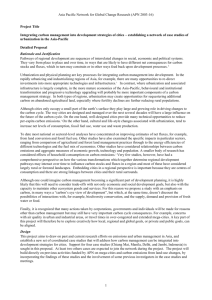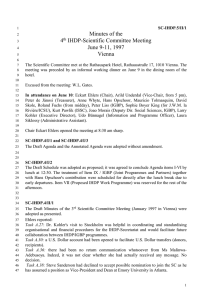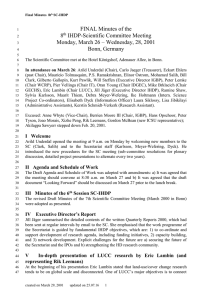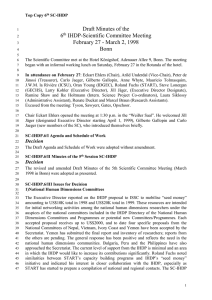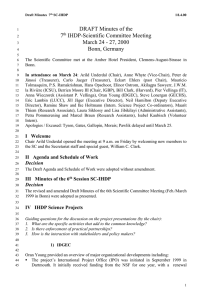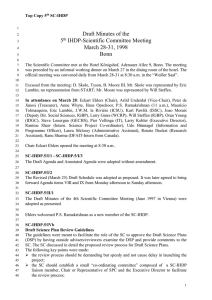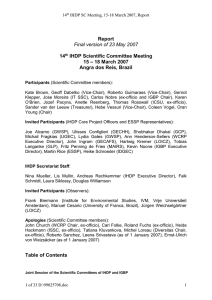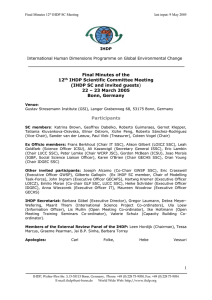IHDP Urbanization Scooping Meeting
advertisement
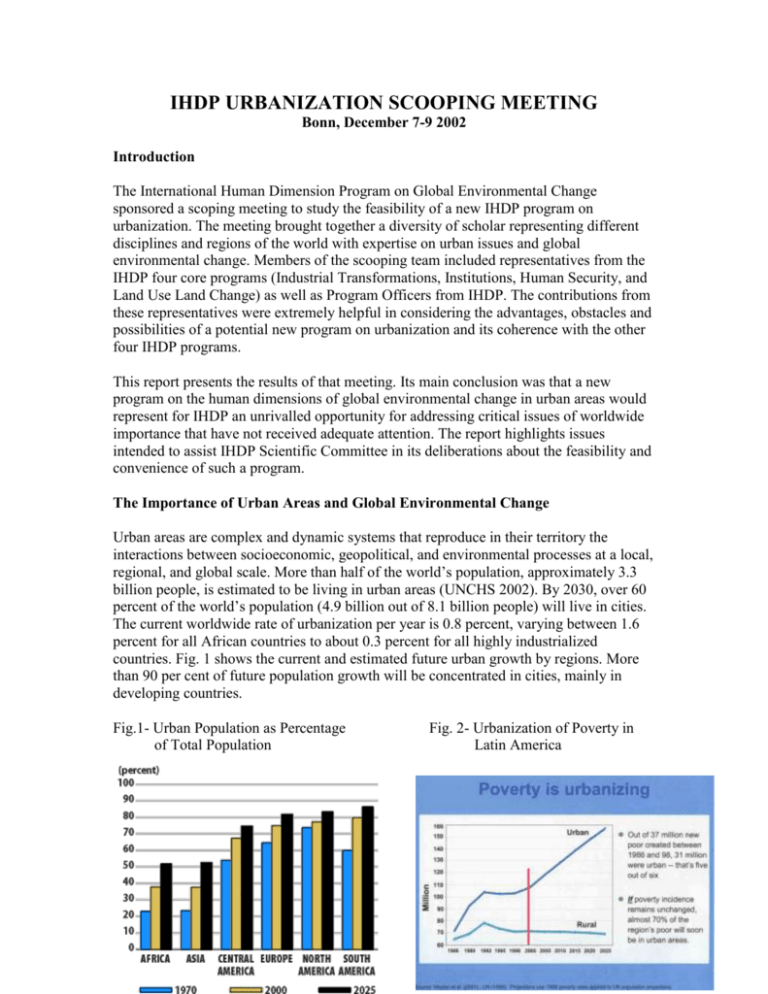
IHDP URBANIZATION SCOOPING MEETING Bonn, December 7-9 2002 Introduction The International Human Dimension Program on Global Environmental Change sponsored a scoping meeting to study the feasibility of a new IHDP program on urbanization. The meeting brought together a diversity of scholar representing different disciplines and regions of the world with expertise on urban issues and global environmental change. Members of the scooping team included representatives from the IHDP four core programs (Industrial Transformations, Institutions, Human Security, and Land Use Land Change) as well as Program Officers from IHDP. The contributions from these representatives were extremely helpful in considering the advantages, obstacles and possibilities of a potential new program on urbanization and its coherence with the other four IHDP programs. This report presents the results of that meeting. Its main conclusion was that a new program on the human dimensions of global environmental change in urban areas would represent for IHDP an unrivalled opportunity for addressing critical issues of worldwide importance that have not received adequate attention. The report highlights issues intended to assist IHDP Scientific Committee in its deliberations about the feasibility and convenience of such a program. The Importance of Urban Areas and Global Environmental Change Urban areas are complex and dynamic systems that reproduce in their territory the interactions between socioeconomic, geopolitical, and environmental processes at a local, regional, and global scale. More than half of the world’s population, approximately 3.3 billion people, is estimated to be living in urban areas (UNCHS 2002). By 2030, over 60 percent of the world’s population (4.9 billion out of 8.1 billion people) will live in cities. The current worldwide rate of urbanization per year is 0.8 percent, varying between 1.6 percent for all African countries to about 0.3 percent for all highly industrialized countries. Fig. 1 shows the current and estimated future urban growth by regions. More than 90 per cent of future population growth will be concentrated in cities, mainly in developing countries. Fig.1- Urban Population as Percentage of Total Population Fig. 2- Urbanization of Poverty in Latin America Today there are 19 cities with 10 million or more people; 22 cities with 5 to 10 million people; 370 cities with 1 to 5 million people; and 433 cities with 0.5 to 1 million people (UNCHS 2002). Growth in mega-cities has begun to decline during the last decade except in Asia and Africa. These two regions will host the largest number of Mega-cities by 2010. However, the fastest growing cities are middle size cities. Although these cities face similar problems to those in mega-cities, they have significant less resources and attention to control them. The large majority of these new urban inhabitants will be poor. It is estimated that between one-quarter and one-third of all urban households in the world live in absolute poverty (UNCHS 2002). This percentage is larger in some regions. Fig. 2 shows that poverty is increasingly urbanizing in Latin America. The World Bank estimates that five out of six new poor created between 1986 and 1998 in that region were urban (World Bank 2000). A similar situation exists in Asia and the Pacific where an increasing number of the entire region's poor live in urban areas (UNCHS 2002). Urban areas are also driving forces in economic growth. Urbanization in the twentieth century established a network of competitive centers that set the physical reference points for today’s globalization. There are the nexus of commerce and the gateways to the world’s economy. The World Bank estimates that in the developing world as much as 80 percent of future economic growth will occur in cities. In some countries, a single city generates a large percent of the national GDP: Bangkok produces nearly 40 percent in Thailand, Sao Paulo 36 percent in Brazil, Lima 43 in Peru. Rapid growth of population and its concentration in urban areas around the world are affecting the long-term outlook for humanity. Now, at the beginning of the 21st century, systems of cities have become a dominant factor in the world’s social, economic, cultural, political, and environmental matrix. Burdened with all the problems of growth, cities are increasingly subject to dramatic crises, especially in developing countries. Unemployment, environmental degradation, lack of urban services and adequate housing, deterioration of existing infrastructure and lack of access to land, and finance, violence, poverty an inequality are among the main areas of concern. Fast and unbalanced growth of urban areas in developing countries have created a fragmented space with high spatial segregation that aggravates the social exclusion characteristic of those societies. It creates a clear division between the formal and informal, the legal and illegal, the rich and poor. Social inequality, the increase of poverty, the real state market and the legal, political, and urban planning systems condition the access to urban land, housing, and public services. Unfortunately, cities have been neglected in the study of global environmental change despite of their importance for economic growth, social well being and the sustainability of present and future generations. The problems in urban areas mentioned above and economic crises aggravate social and urban vulnerabilities to the negative consequences of global environmental change. The development of contemporary societies will depend largely on understanding and managing the growth of urban areas. Rationale The specific focus of this potential new core project should be on the interactions between global environmental change and urban processes. These bi-directional integrations and processes may increase the rate, intensity and scale of urban and environmental change. Such change may be both positive and negative for different places and groups at different times. The extent of potential negative changes represents a substantial challenge to the functioning, stability and sustainability of urban areas. Although these changes will be felt in both the global North and South, they will present a greater threat in the latter. The committee stressed the fact that substantial knowledge has already been accumulated from disparate research on various aspects of urbanization and global environmental change. The strength of this new program will lie in building on these foundations in creating an innovative and integrated perspective. Urban studies have a long tradition in the social sciences (urban economy, urban sociology, urban anthropology, urban politics, and urban geography), in the engineering science and arts (urban transportation, urban infrastructure, urban design), as well as in the professional field of planning (urban and regional planning, public administration). Contributions from the natural sciences have also expanded our knowledge of urban issues (urban climate, urban metabolism, ecological services, urban habitat conservation, urban geology and hydrology, urban environment). Missing so far is a perspective integrating the contributions from these disciplines. This integrated perspective is essential to a better understanding of the complex and dynamic realities of urban areas. A potential IHDP program on urban issues should create new multidisciplinary and interdisciplinary knowledge through innovative conceptual and methodological approaches. This new knowledge will be generated through a combination of pure and applied research and it will help IHDP develop a comprehensive framework for examining and addressing the complex realities of urban areas and their interactions with global environmental change. This represents an unrivalled opportunity for addressing critical issues of worldwide importance that have not received adequate attention. As stated above, these issues have severe social, economic, and environmental consequences for urban areas in developed and developing countries, particularly those areas already experiencing increasing environmental stress. The scooping commission believes that this new program will place IHDP in a unique position of facilitating mutual learning and assistance between North and South on these issues. The scooping committee recognized that the study of the human dimensions of global environmental change in urban areas represents a broad research agenda beyond the current emphasis on mega-cities and the impact of cities on the biochemical cycles. The committee felt strongly that a potential IHDP program could provide adequate response to the diversity of issues in small, middle and mega-cities created by the interactions between urban processes and global environmental change. The following suggestions represent some key issues the committee considered should be included in a potential new IHDP program: Urban areas are part of wider geopolitical and socioeconomic processes and environmental systems at different spatial and temporal scales Urban issues and their interaction with environmental systems need to be understood within the framework of global geopolitical, socioeconomic and environmental processes. These processes influence and shape the driving forces behind urban growth, the level and characteristics of the urbanization process, and the type of interactions between urban areas and the environment. Considering urban growth only as the outcome of local forces creates an incomplete perspective of complex realities. Some evidences of these global processes are: the dynamic movement of financial capital or transnational industrial operations around the world, the impact of a free market ideology, international political conflicts, the daily migrations of thousands of people from rural to urban areas, the displacement of people by military conflicts. Urban areas are the main locus of these processes and they constitute strategic components of them. Some scholars have portrait the manifestation of these global processes in terms of networks of world cities (Taylor el.al. 2002), transnational urban systems (Sassen 1994), or global urban network (Lo and Yeung 1998). These world cities host headquarters of major corporations, financial capital, political systems (the loci of command and scope of power). However, middle size and even small urban areas are also embedded in globalization processes through the flow of commodities, resources, people, and culture. A combined perspective of geopolitical and socioeconomic processes together with environmental systems facilitates the creation of integrated and interdisciplinary perspectives needed in the study of the interactions between urban processes and global environmental change. The interactions among urban function, urban form and regional and global environmental change must be examined Urban areas are complex and dynamic systems. As mentioned above, their growth and urbanization process is influenced by a number of global, regional and local forces. Urban function and urban form are the physical manifestation of the interactions and conflicts among those forces in the urban space. Those manifestations also define the positive and negative bi-directional interaction with regional and global environmental change. Examples of these interactions are the impacts of different land uses within the urban areas on the creation of microclimates or the consequences of climate variability and climate change on natural disasters in urban areas. The research focus must include analysis of relevant processes and impacts in adjacent peri-urban areas Peri-urban areas fulfill key functions for urban areas, from the supply of inputs (food, energy, water, building materials), the provision of ecological services, and as buffer areas for migration flows. They also suffer the negative consequences of urban areas (pollution, urbanization pressures and land use changes, degradation of natural resources). Peri-urban areas also function as a key interface between urban and rural areas through the provision of essential services to rural areas. Despite their importance, the study of peri-urban areas has been neglected in urban and environmental studies. Small and middle size urban areas require balanced attention as mega-cities Mega-cities have received significant attention in urban studies during the last decade. The excellent compilation of mega-cities around the world, sponsored and published by the United Nations University, illustrates their economic, social, environmental and political importance. It is clear that the attention provided so far to mega-cities is justified. Much less attention has been provided to small and middle size urban areas despite their economic, social, and environmental importance. Although mega- cities continue to growth fast in some regions, population growth tends to concentrate more in middle size urban areas. Small and middle size cities have a different set of problems, conditions, resources and opportunities than mega-cities. They create a different set of urban processes and interaction with global and regional environmental change. Integration among supranational, national and subnational institutions is important to ensure effective governance and policy responses in addressing the impacts of global environmental change Urban issues and their associated environmental problems are often considered at their local scale. However, urban areas create bi-directional processes with the environment that cut across scales, from the local to the regional and global. Addressing these processes requires the coordination of supranational, national and subnational institutions. Effective policies and responses to the challenges of global environmental change can only be created if the array of scales involved in them is addressed. Stakeholders at different scales need to be distinguished and included Urban issues have a large number of stakeholders involved in improving local conditions at different scales, from national governments to local authorities, planners, public officials and a diversity of civil actors at the city, neighborhood, and household level. The level of human agency in this topic is significantly higher than in many other areas of the human dimensions of global environmental change. These resources constitute a formidable structure to implement policies and program at a diversity of scales. A central feature is the focus on the nature of different impacts, and possible adaptations, mitigations and coping strategies of vulnerable areas and people Recent contributions from scholars have provided a multidimensional and multiscale interpretation of the concept of vulnerability that represents a development from its frequent technical interpretation in disaster awareness and preparation (Blaikie 1994, Adger 1999, Bohle and Watts 1999, Cannon 2000). Under this interpretation, vulnerability becomes a useful analytical tool to study the interactions between social and natural processes. It facilitates addressing the impacts of bi-directional interactions between urban areas and global environmental change, as well as the possible adaptation, mitigation and coping strategies. There is a need to include both ‘pure’ and applied aspects of research An integrated and comprehensive perspective of the human dimensions of global environmental change in urban areas requires contributions from natural and social sciences, as well as applied and ‘pure’ science. These contributions are essential to the development of innovative conceptual and methodological approaches capable of analyzing complex realties and facilitating the translation of scientific research into efficient and relevant policies for the short, middle and long term. Coherence with other IHDP Programs The scooping committee took special attention in considering the coherence and compatibility between a potential IHDP core project on urbanization and the four current IHDP projects. The committee felt strongly that the potential new program offers an excellent opportunity to supplement and strengthen the current four IHDP projects. The Industrial Transformation Project is the project that most clearly defines an interest in urban issues. It research focus concentrates on transportation and water as well as the measurement and modeling of these two topics. The main objective of this research is to discover whether and how there could be a de-coupling of the improvement from the negative environmental effects of the production and consumption systems that sustain life in cities. Much of the emphasis on both research topics is finding ways to reduce the impact of cities on the biochemical cycles through industrial transformations. As mentioned above, the human dimensions of global environmental change in urban areas covers a diverse range of issues. The scooping committee considered that a potential new project addressing the diversity of other urban and environmental issues not covered by the IT core project would complement and strengthen its research on cities. Land Use and Land Cover Change core project does not explicitly address the topic of urbanization in its Science Plan/ Implementation Strategy. However, there is close link with the potential new IHDP core project on urbanization through the impact of land use and land cover changes embedded in research oriented to understand regional processes and its social and biophysical driving forces. A new core project on urbanization would open the opportunity for extensive mutual support with LUCC’s research agenda. A similar situation exists in the case of IHDP’s third core project, Global Environmental Change and Human Security (GECHS). There is not and explicit them in its Science Plan addressing urbanization. There are two common research areas of interest with GHECHS in terms of urbanization: water and vulnerability. As in the case of LUCC, the scooping committee felt strongly that a new core project on urbanization would provide mutual support to GECHS research agenda. The Institutional Dimensions of Global Environmental Change core (IDGEC) project does not address urbanization in its Science Plan nor in its Flagship Activities. However, IDGEC identifies an interest on urbanization that could lead to mutual support with a potential new core project on urbanization. IDGEC research foci focuses on the role that social institutions play in causing and confronting global environmental change. It singles out the roles of environmental and resources regimes defined as institutional arrangements concerned explicitly with human – environment relations. This research foci offers linkages with the human dimensions of global environmental change in urban areas. Additionally, the new Carbon Joint Project has some linkages with urbanization primarily addressed in the context of the consequences of regional development pathways for the carbon cycle. The CJP plans to include among the regions to be included in the study, developed regions with big cities and highly modified landscapes. A potential new project on urbanization would a network of experts, case studies and experience in support of the CJP activities and offer the possibilities of complementary research. Opportunities Urban issues are obtaining increasing attention by a number of international organizations and national and local governments. The UN Habitat program and its environmental program, the World Bank, the OECD, the European Union, the Inter American Development Bank, the Asia Pacific Network, and others international organizations sponsor a number of initiatives addressing a diversity of urbanization issues relevant to economic growth, the social well being of urban inhabitants, and the urban environment. Although some of these efforts were first established some decades ago, a significant number of them were launched only a few years ago. These efforts illustrate a trend in the creation of international networks of cities to facilitate the exchange of information and capacity building at the local level on urban and environmental issues. Some of the most important networks are: Metropolis. The International Union of Local Authorities (which will launch a new program, United Cities and Local Governments in January 2004). The Congress of Local Governments The International Council of Local Environmental Initiatives (ICLEI) The American Union of Capital Cities (cities in Latin America and Spain) The International Solidarity Fund of Cities against Poverty The International Network of Urban Initiatives Global Cities Dialogue Two brief examples help illustrate the focus, scope and outreach capacity of these networks. Metropolis is an international association of 76 global cities. It works towards developing solutions to problems in large cities (planning, development, the environment, the economy, infrastructure, communications, and transport). One of its programs, Cities Alliance launched in 1999, has two ambitious components: City development strategies focusing on the stakeholders vision of their city, its economic prospects and its priorities for action and investment; City-wide and nation-wide slum upgrading to improve the living conditions of at least 100 million slum dwellers by 2020. Metropolis provides also training services on urban and environmental issues (Metropolis Training Institute) directed to elected representatives, managers and executives of metropolitan governments. The International Council of Local Initiatives (ICLEI). ICLEI is an association of local governments implementing sustainable development. Its membership is estimated of more than 400 cities, towns, and counties in different parts of the world (developed and developing countries). Its agenda concentrates in three major programs: A Local Agenda 21 Campaign, a Cities for Climate Protection Campaign, and a Water Campaign. Its international services include training programs for local governments. ICLEI and Metropolis have created partnerships with a number of international organizations (World Bank, UNEP, UNCHS, the International Union of Local Governments among others). ICLEI, Metropolis and the other networks mentioned above represent a diversity of outreach capacity, scope, experience, and resources. They are also an interface to reach a large number of local governments and stakeholders in urban areas through out the world. These networks are valuable assets to a potential IHDP program on urbanization. They offer the opportunity to reach and disseminate information and knowledge on the human dimensions of global environmental change in urban areas to decision-makers and stakeholders at a local level in developed and developing countries. In fact, IHDP could play a major role in upgrading the agenda of these networks. During the preparation of this report, we reviewed to what extent these networks and other international organizations with a key interest in urban issues (World Bank, UNEP, UNCHS, OECD, BID) consider in their programs issues related to the human dimensions of global environmental change. Our results show that although the programs of these institutions cover a wide range of urban and environmental issues directly associated with a broad perspective of the human dimensions of global environmental change in urban areas, only a few of them have a direct reference to this human dimension. Some exceptions are ICLEI’s program on Cities for Climate Protection Campaign, and to some extent UNCHS focus on natural disasters and ecocities. But even these programs represent only a fragmented perspective of the diversity of topics covered by the human dimensions of global environmental change in urban areas as state above by this scoping report. While the city networks and their sponsoring organizations have yet not focused on the human dimensions of global environmental change, their provide the potential infrastructure to facilitate the transformation of scientific knowledge into policy and programs at a local level. The resources devoted by these organizations to disseminate information and train local governments and stakeholders are an excellent channel and opportunity to transmit the knowledge and information generated by IHDP and other partners to a wide range of actors involved in urban life.1 A potential IHDP program on 1 A number of resources are used to disseminate information. Some of the best known examples related to the human dimensions of global environmental change in cities are: UNEP’s Global Environmental Outlook and Earthwatch, UNCHS’ The State of the World Cities, its Global Urban Observatory and its Best Practices Data Base, UNEP and UNCHS’ Urban Indicators, UNEP’s Environmental Management and Resource Alliance for Development (EMERAID, an Internet portal serving urban managers), and MAESTRO (an environmentally sound technologies data base). Despite the close links between the topics addressed by these resources and the human dimensions of global environmental change, there is little reference to the later in them. urbanization would be a perfect match to the above mentioned international initiatives seeking to improve urban, social, and environmental conditions in urban areas. The current international attention to urban areas opens also opportunities to the development of a new program on the human dimensions of global environmental change in cities. International organizations like the World Bank and United Nations have expanded their attention to urban issues and they sponsor a number of initiatives in developing countries. But perhaps more the most interesting and innovative initiates are those emerging from the networks and partnership established among cities through out the world. These initiatives represent an effort to create North-South and South-South cooperation. IHDP could capitalize on this growing interest on urban areas. One of the biggest challenges for the community studying global environmental change is the translation of scientific research into policies, programs and actions seeking to control the negative aspects of those processes. The human dimensions of global environmental change in urban areas offer opportunities to facilitate that transition not present for other aspects of global environmental change. As mentioned above, substantial knowledge has already been accumulated from disparate research on various aspects of urbanization and global environmental change. This facilitates the creation of innovative conceptual and methodological approaches that can generate new knowledge relevant for policy making. Urban issues have a large number of stakeholders involved in improving local conditions at different scales, from national governments to local authorities, planners, public officials and a diversity of civil actors at the city, neighborhood, and household level. The level of human agency in this topic is significantly higher than in many other areas of the human dimensions of global environmental change. These resources constitute a formidable structure to implement policies and program at a diversity of scales. Current urban and environmental policies in urban areas do not address the interactions with global environmental change. Many of the current policies and investments in urban areas could address the negative consequences of global environmental change, providing they incorporate relevant knowledge and information generated by the scientific community. Incorporating the human dimension of global environmental change in urban policies often does not represent a significant increase in the level investment required for them. For example, incorporating data on extreme events created by climate variability and climate change in the planning of urban infrastructure (drainage systems), land use planning, vulnerability analysis can significantly improve the outcome of those policies and programs. Uncertainty is often mention as a limiting factor for the translation of scientific data in global environmental change into policies, particularly in terms of the costs and benefits of investing in global environmental change policies. The role of uncertainty is limited in the case of urban areas since many of the policies link global environmental issues with current problems and deficiencies in the urban areas and their environment. The example mentioned above illustrates that even in the case of failed forecasts or uncertainty, urban areas would still benefit from policies addressing global environmental change.




